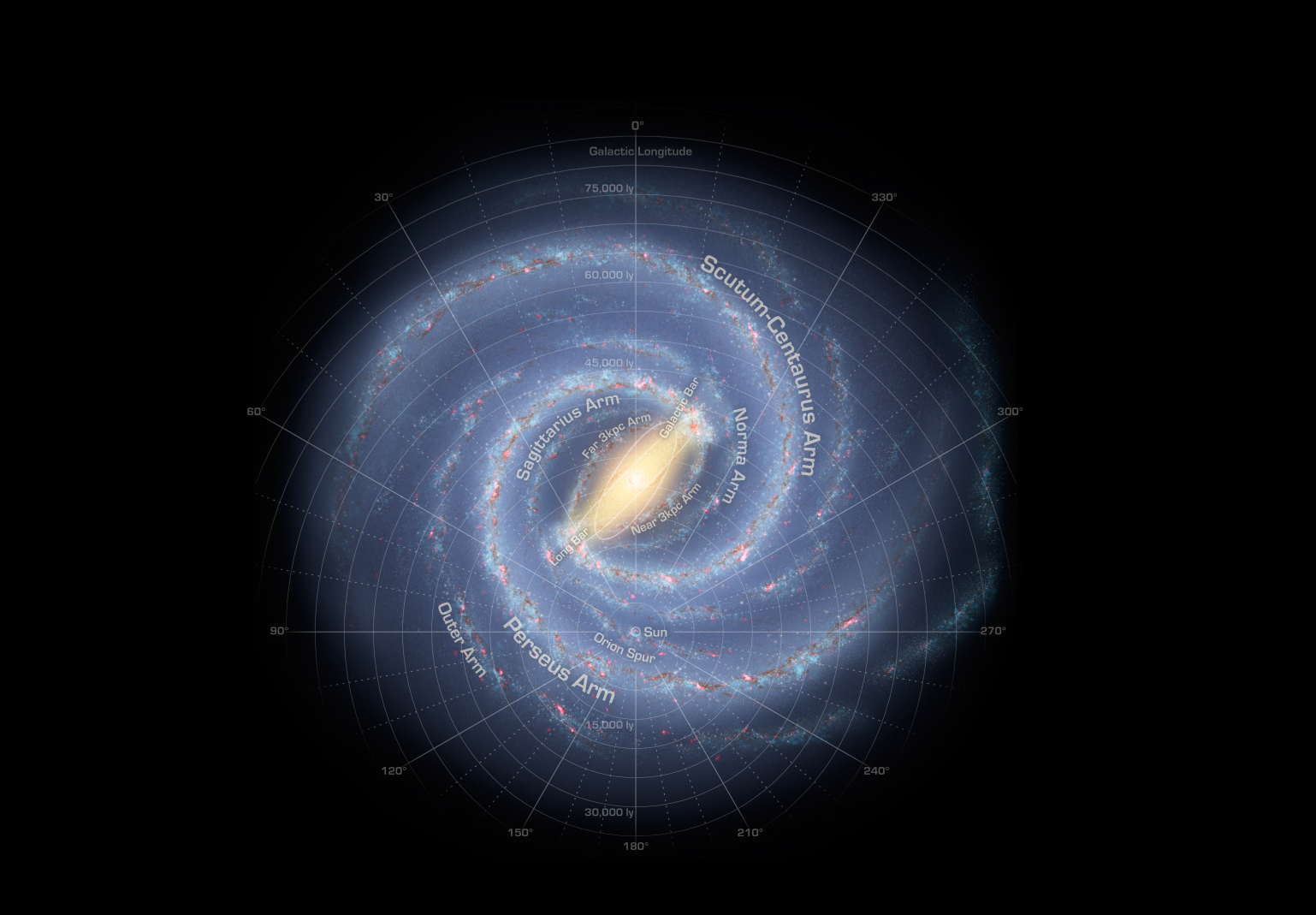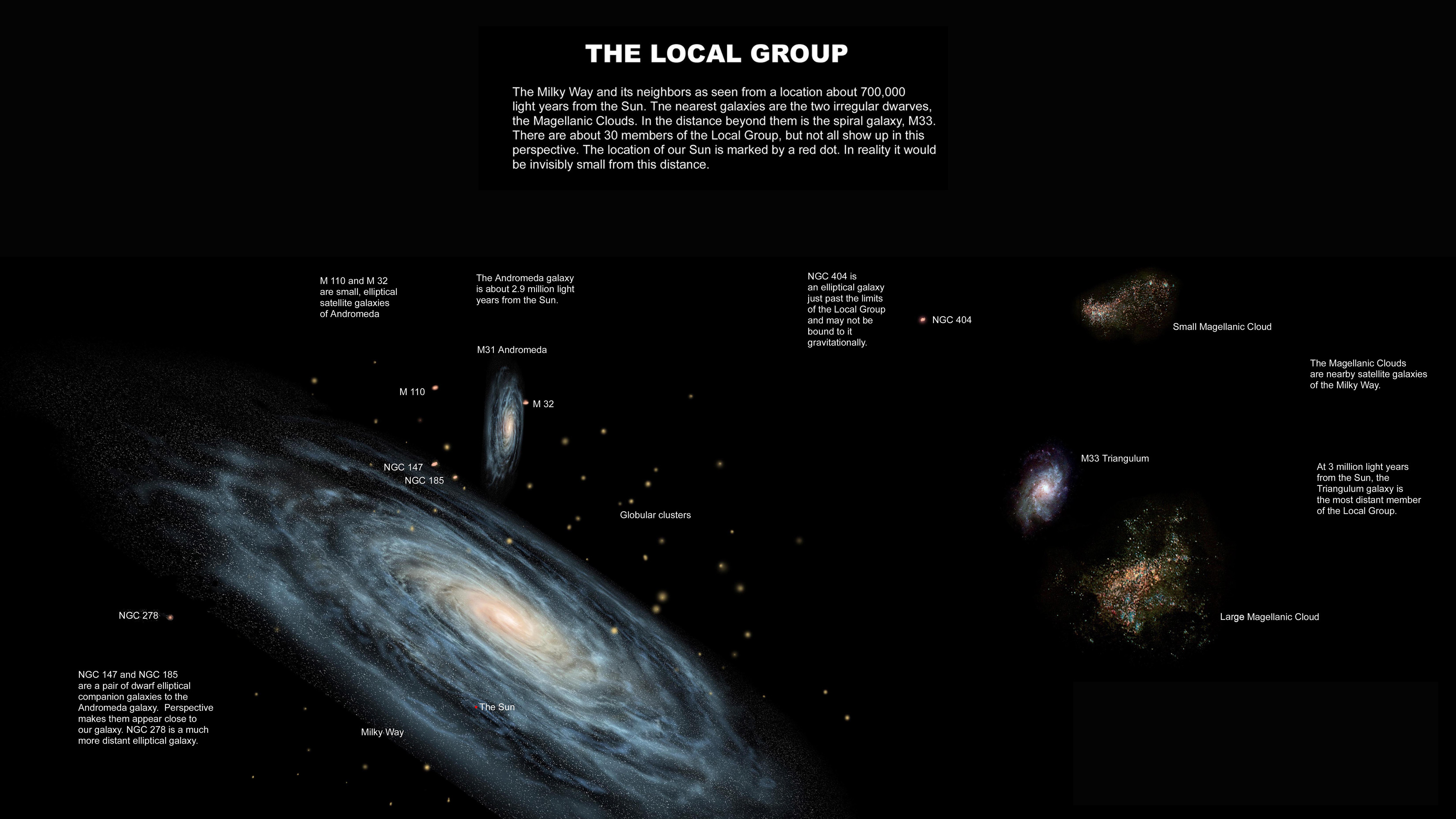What is the Milky Way?
Let's dive into the science of our home galaxy, the Milky Way.

The Milky Way is a barred spiral galaxy, one of hundreds of billions in the observable universe. It's also our home.
Like other galaxies, the Milky Way is an isolated collection of stars and other material bound together by their common gravity. In addition to the 100 billion to 400 billion stars in our galaxy, a similar number of planets likely exist in the Milky Way — some of them part of solar systems and some floating freely. Between the stars sit innumerable nebulas, which are clouds of gas and dust. The vast majority of the interstellar gas is hydrogen and helium.
However, multiple lines of evidence — most importantly, that material in the galaxy orbits the center far too quickly to be held together by the gravity of visible objects — suggest that most of the mass of the Milky Way is made up of some form of matter that does not interact with light. Astronomers call this dark matter, and its true nature is not fully understood.
Who discovered the Milky Way?
From our vantage point on Earth, the Milky Way looks like a band of diffuse light that arcs across the nighttime sky. This is where the English name comes from: The Romans called it Via Lactea and envisioned it as a band of spilled milk. Astronomers and philosophers debated the nature of the Milky Way until Galileo Galilei first observed it with a telescope and found that the light of the Milky Way comes from innumerable distant stars. The stars themselves are too far away to see all of them individually, but their combined light gives the familiar band.
Up until the early 1900's, astronomers assumed that the Milky Way contained all the stars in the universe (either the Milky Way extended to fill the entire cosmos, or it was a finite size and surrounded by an infinite void). However, in the early 1920's, astronomer Edwin Hubble made detailed observations of the Andromeda Nebula, revealing that it was its own "island" of stars — a galaxy in its own right — located millions of light-years away from us, according to Britannica.
What does the Milky Way look like?
The Milky Way is a relatively thin, flattened disk. This explains why it appears as a band in our sky. When we are looking in the direction of the disk, Earthlings see the combined light of all the stars in the galaxy. When we look in a direction away from the disk, we see only the stars close to our solar system.
The Milky Way has three main parts: the core, the disk and the halo.
Get the world’s most fascinating discoveries delivered straight to your inbox.
The core isn't spherical; it's elongated into the shape of a bar anywhere from 5,000 to 20,000 light-years long. Up to a quarter of all the stars in the Milky Way reside in the core; the density of stars there is up to a million times greater than it is in the neighborhood of the sun, according to the Space Telescope Science Institute. At the very center of the galaxy sits Sagittarius A*, a supermassive black hole with a mass that's 4.1 million times that of the sun, according to the UCLA Galactic Center Group.
The stellar disk of the Milky Way has a radius of 75,000 to 100,000 light-years, but it is only about 1,000 light-years thick. Within the disk sit several major spiral arms, according to NASA, where the density of stars and gas is higher than average and star formation occurs at a higher rate, making these arms stand out in visual observations.
Our solar system sits in the disk, about 27,000 light-years from the galactic center, near the inner rim of the Orion Arm.
Beyond the disk of the Milky Way is its halo, which is a spherical region with a radius of about 100,000 light-years. The halo contains old stars and globular clusters, all orbiting the galactic center in random directions. The dark matter extends even farther, up to 400,000 light-years from the center, according to a study published in 2019 in the journal Astronomy & Astrophysics.
Where is the Milky Way?
The Milky Way has two major satellite galaxies — the Large and Small Magellanic Clouds — and dozens of smaller satellites. Our nearest neighbor is the Andromeda galaxy, located about 2.5 million light-years away. Together with Andromeda and about 80 smaller galaxies, the Milky Way is a part of the Local Group, which is a group of galaxies, about 10 million light-years across, bound together by their common gravity, according to Swinburne University.
The Local Group is one member of a larger structure called the Virgo Supercluster, which is surrounded by several great intergalactic voids, according to Durham University. At the center of this supercluster sits the Virgo Cluster, a massive collection of 1,000 to 2,000 galaxies about 54 million light-years away. The Virgo Supercluster itself is thought to be a component of an even larger structure called the Laniakea Supercluster.
How big is the Milky Way?
It's difficult to estimate the true size of our galaxy, because we live inside it and all the clouds of gas and dust obscure our observations of it. Astronomers estimate that the total mass of the Milky Way is around a trillion times the mass of the sun, according to NASA. Most of that mass, by far, is in the form of dark matter; stars represent around only 1% of the mass of the galaxy, and interstellar gas accounts for only 0.1%.
Is the Milky Way moving?
Relative to the general expansion of space that pulls galaxies away from each other (on average), the Milky Way is moving at approximately 391 miles per second (630 kilometers per second), scientists reported on the preprint server arXiv in 2005. Our galaxy is on a collision course with Andromeda, and our two galaxies will crash and begin to merge in about 5 billion years.
Both the Milky Way and Andromeda are moving together in the direction of what's called the Great Attractor, the University of Hawaii Institute for Astronomy reported. The Great Attractor is thought to be the center of the Laniakea Supercluster. However, observations of this region of the local universe are difficult because it lies past the direction of our galactic center, which obscures our view.
Additional resources
—California Academy of Sciences has this great educational video that lets students tour the Milky Way.
—This National Geographic Book "Visual Galaxy" has gorgeous images of the Milky Way.
—Check out these activities and resources about the solar system and night sky at the McDonald Observatory.

Paul M. Sutter is a research professor in astrophysics at SUNY Stony Brook University and the Flatiron Institute in New York City. He regularly appears on TV and podcasts, including "Ask a Spaceman." He is the author of two books, "Your Place in the Universe" and "How to Die in Space," and is a regular contributor to Space.com, Live Science, and more. Paul received his PhD in Physics from the University of Illinois at Urbana-Champaign in 2011, and spent three years at the Paris Institute of Astrophysics, followed by a research fellowship in Trieste, Italy.




